Here’s everything you need to know about BLW first foods and age recommendations for introducing solids.
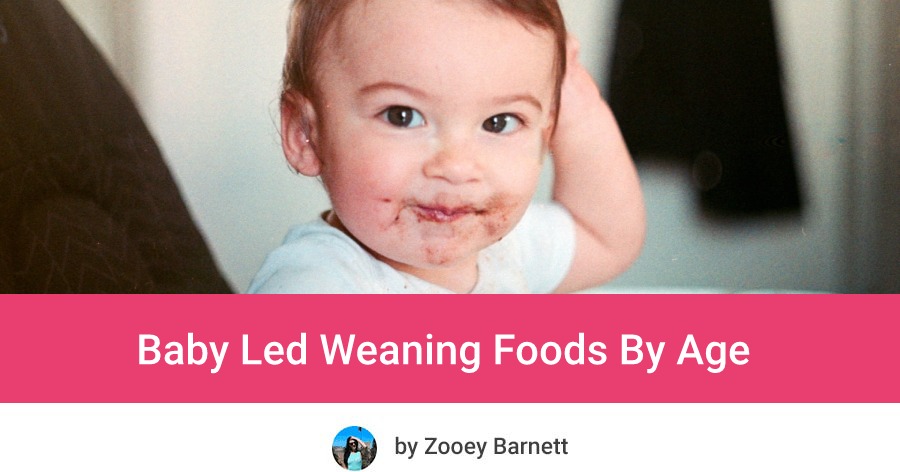
Introducing solid foods to your baby can feel stressful: for months all they’ve ever had is breast milk or formula and then one day you introduce them to their first solid food. What should baby’s first foods be? Purees? A vegetable smoothie? Baby oatmeal? Or… finger foods?
The baby-led weaning approach, also known as baby-self feeding, is a feeding philosophy that emphasizes your child feeding him or herself. It can feel a bit intimidating to allow your child to practice self feeding at first, but there are several proven benefits to baby-led weaning.
This article is NOT a substitute for medical advice.
Benefits Of Baby-Led Weaning
- Improved fine motor skills,
- Your baby eats until they are full, making them more attuned with their own hunger and fullness cues,
- Your child gets to be a part of family meals,
- Parents enjoy meals, too, because they are not spoon feeding the baby.
Baby-led weaning studies also suggest that as children eat solid foods on their own, they showed a willingness to try new foods and less picky eating than their traditional-weaning counterparts who were spoon-fed purees.
Because babies cannot hold a spoon to feed themselves purees, baby-led weaning encourages babies to eat finger foods that they can pick up and self-feed. It’s usually pretty messy at first, but as they continue to practice eating on their own, they develop better coordination, too.
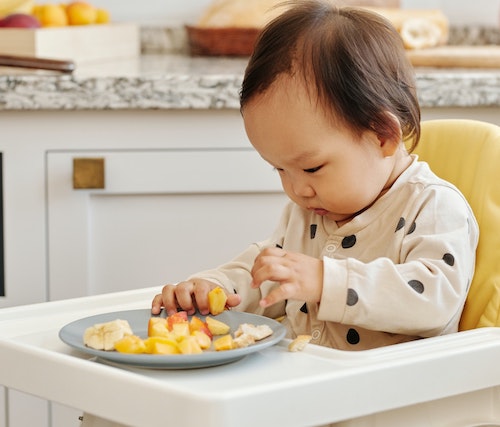
There is no rule that you have to do exclusive baby-led weaning, though. Some moms decide to serve baby oatmeal or purees for breakfast, and let lunch and dinner be baby-led weaning time.
Mama, let this be your own baby led weaning journey, you don’t have to follow anyone else’s feeding schedule. Just make sure your little one is fed and healthy. Whether you mix baby-led weaning with some spoon feeding, or are exclusively doing baby led weaning, that’s up to you.
| PRO TIP: To make your journey with baby-led weaning easier, you will need some accessories for your baby. Check out my favorite BLW bibs that will keep all crumbs and spills contained and choose the best BLW high chair that will keep your baby in ergonomic position during the mealtime. |
When To Start Baby Led Weaning
Experts suggest parents start baby led weaning when a child shows signs of developmental readiness:
- Muscle strength necessary for sitting in a high chair (ability to sit up independently),
- Sufficient coordination to pick up food and bring it to their mouth (fine motor skill development)
- Showing increased interest in food (baby starts reaching for food)
Now, most babies can sit independently and reach for things at 6 months, but if your little one isn’t there quite yet, don’t worry.
You can start spoon feeding with purees, if you want to, and slowly phase them out as your child begins eating finger foods more regularly.
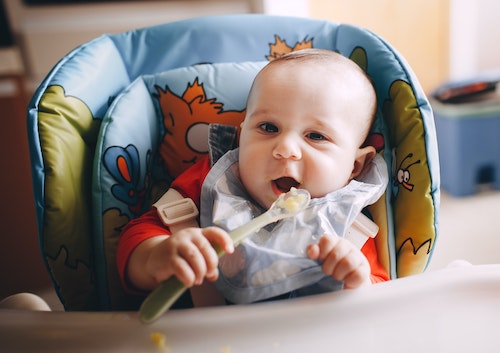
At first, baby may not eat the food. They might just play with it, smash it in their hair or throw it on the floor. This is all part of the process of learning and experimenting with food.
Don’t focus too much on your baby obtaining nutrition from food during the first month, it’s just about getting the idea of chewing and swallowing in the beginning.
Also, your baby may not swallow right away – remember, they’ve only ever had liquids before this. If your baby gags, remember this is normal. They will gag sometimes as they learn how to swallow.
Finger Foods – Better Than Purees?
Let’s address a common question straight away: baby-led weaning versus spoon feeding, which is better?
Mama, one is not better than the other here, but one may be more convenient than the other. Many parents enjoy baby-led weaning simply because they don’t have to prepare a separate, pureed meal for baby.
Baby enjoys the same food the rest of the family is eating. Also, no one has to spoon-feed the baby, because baby is feeding him or herself.
However, you may need to modify foods for your family meals: reduce salt or spices and cut baby food into strips or small slices they can easily grab.
On the flip side, some parents may have concerns if their child is getting sufficient nutrients through baby-led weaning foods (or because they see so much food dropped on the floor instead of getting into baby’s mouth).
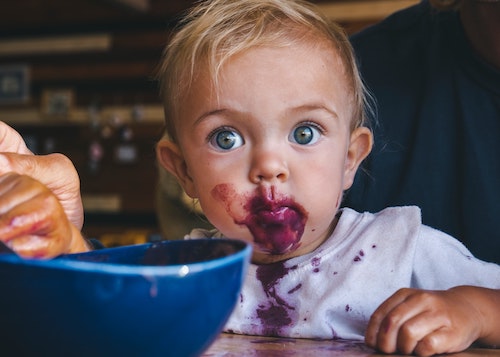
For the most part, milk (either breast milk or formula) makes up the bulk of the protein and calories that a child requires for the first year of life.
One approach you could try is mixing solid foods and pureed foods for a combo baby-led weaning approach. This might look like spoon-feeding purees while at the same time, offering small chunks of solid food on their high chair tray.
Or, you could try doing baby-led weaning for one meal a day until they begin to eat new food more independently.
Breastfeeding & Baby Led Weaning
If you are nursing, then you should continue breastfeeding while introducing solids to your baby. You should also keep nursing every few hours to keep up your breastmilk supply.
At six months of age, your baby should still consume milk 5-7 times a day, no matter when you are offering solids throughout the day. If you are exclusively breastfeeding, continue nursing every 3-4 hours during the day.
How To Start BLW
Here are my useful tips for preparing first foods and staring BLW.
Remember It Is A Learning Process
No matter what you’re offering as first foods for baby, he or she won’t know how to chew foods and swallow them. They also have to practice hand-eye coordination to bring food to their mouth.
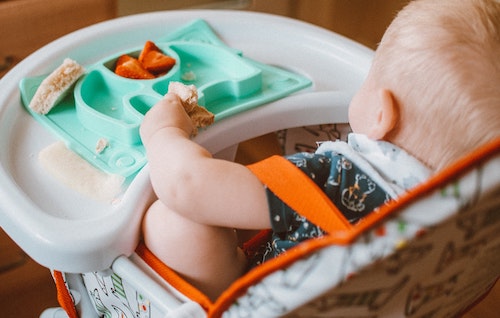
This action must be learned, so for the first weeks, keep your expectations low: let baby mash the food and spit it out, allow them to play with it, explore the different textures and tastes and don’t feel like giving up because more food landed on the floor than in your baby’s mouth.
When you introduce first foods for baby, make sure offer food that is warm, but not hot to the touch, and limit distractions so your child can focus on the food in front of them. In time, you will see your baby eat more food independently.
Finger-Sized Foods
Prepare foods into finger-sized pieces for baby to pick up and put into their mouth. I love the example of fingers, because it reminds you to cut long, slim pieces, approximately the size of your middle or index finger – yes, an adult-sized finger.
The food should be long enough to be grasped in your child’s hand, with some part still sticking out for them to put into their mouth.
Give Fewer Pieces At Once
Don’t load your baby’s highchair tray with lots of pieces of food, it can overwhelm them and they are more likely to throw the food around. Instead, put only one or two pieces of food in front of them. Continue adding one or two pieces to their tray as they eat, without rushing them.
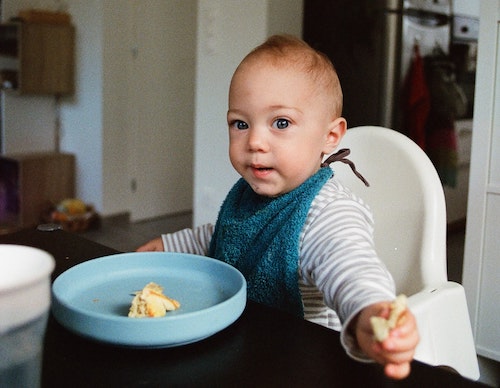
Know The Difference Between Choking And Gagging
Parents, you must prevent choking risk as much as possible and always supervise your child while they are eating.
But remember, young children have a strong gag reflex and they are just learning how to chew and swallow solid food.
If your child is making noise, coughing or gagging out their food, rest easy: this is gagging and is part of the weaning process.
Foods to avoid that pose a choking hazard are mentioned further below. Keep in mind that if BLW is done properly and following all safety recommendations, choking risk is not higher than with other methods.
| An infant who is choking cannot make noise, because their airway is blocked. Parents must follow first-aid protocols to expel the blocked item and remove it from the mouth. Reduce choking hazards by cutting foods into small, long pieces or bite-sized pieces and never offer hard-to-chew or round foods for baby-led weaning. |
First Baby-Led Weaning Foods
For both traditional weaning and baby-led weaning, it’s important to follow weaning foods by age. When starting solid foods, introduce age appropriate foods that have a light taste and can be served in a soft state that is easy for babies to grab (i.e. finger foods) and mash with gums as they likely don’t have many teeth yet.
Foods that have a high amount of acid (like citrus), or other foods with a strong, distinct taste should be given after a few months.
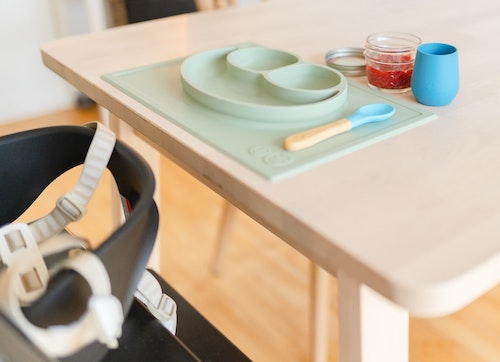
Baby-Led Weaning First Foods At 6 Months
Babies start to loose their iron stores around 6 months of age, so some of the best first foods for baby are high in iron. Try pairing with foods that are high in vitamin C for optimal iron absorptions in the body. Beans, lentils, avocados, broccoli, fish, and chicken are all great sources of iron. Mashed kidney beans served together with peaches or sliced strawberries is a great combination for first solid foods.
At this age, your baby may only have one meal a day and continue their regular milk intake.
Best First Foods At 6 Months
- Steamed green beans
- Steamed carrots
- Steamed broccoli
- Sweet potatoes
- Ripe fruits (ripe peach slices, sliced strawberries)
- Ripe avocado
- Roasted butternut squash bits
- Banana strips
Other Foods That Are Smaller Than Finger-Sized
- Clumps of oatmeal
- Rice and lentil patties
Babies have a hard time picking up tiny bits of food, like grains of rice or lentils. A good way to serve these nutritious foods is by mashing cooked rice or lentils and serve as clumps.
My Recipe For Lentil Patties For BLW At 6 Months
I like to prepare nutritious lentil patties as a first food to my kids. Here’s the recipe:
Ingredients:
- 1/8 cup grated carrots
- 1/2 tsp minced garlic
- 1/2 cup cooked lentils, drained
- pinch of salt
- pinch of ground cumin (optional)
- 1/8 cup finely chopped spinach
Instructions:
Cook the garlic, carrots and spinach with a bit of olive oil over medium heat for approximately 1-2 minutes, until soft.
Prepare the drained lentils in a small bowl and add salt and cumin (if desired). Add the cooked vegetables to the lentils and form into small, flat patties (approximately the size of your palm).
Add a bit more olive oil to your pan and cook the patties for 1-2 minutes on each side, until slightly brown but not crispy.
Cut patties into finger-size strips and allow to cool before serving to your child.
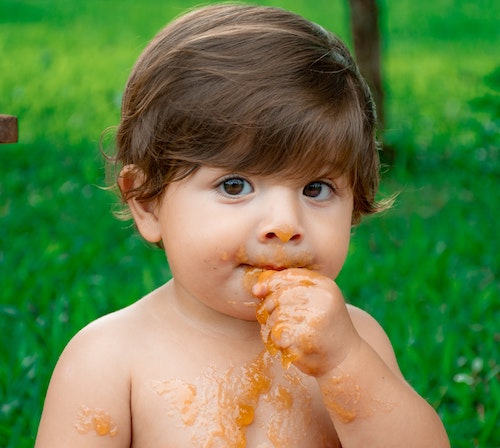
Baby-Led Weaning Foods At 6-8 Months
Between 6 and 8 months, you may be feeding your child two small meals each day. As your child gets used to their feeding schedule, and more confident eating solids, try introducing more flavors, and perhaps one or two common allergenic foods, according to your doctor’s recommendations.
You can also serve familiar foods, prepared differently: roasted broccoli florets instead of steamed broccoli, roasted sweet potato wedges instead of steamed sweet potatoes.
Some Foods To Introduce At Stage Of 6-8 Months
- Shredded chicken/ground meat and fully cooked pork (but hold off on sausages and hot dogs, though – they pose a choking risk)
- Flaked or shredded fish (wait to offer shellfish, such as shrimp, until 10 months)
- Sliced beetroot
- Thick mango slices with the peel on
- Roasted pumpkin bits
- Egg (sliced, hard boiled eggs are a very healthy choice)
- Homemade pancakes without added sugar, made with spinach, pumpkin or beetroot (if you haven’t started eggs, substitute mashed bananas or apples in your recipe)
- Diary products, like yogurt (although you may want to spoon feed this to your child)
- Tofu (tofu scramble is a personal favorite!)
Baby-Led Weaning Foods At 8-10 Month
At this stage of baby-led weaning, your baby should be enjoying a variety of foods and eating up to three meals, just like you. They are likely enjoying eating different foods and interested in meals.
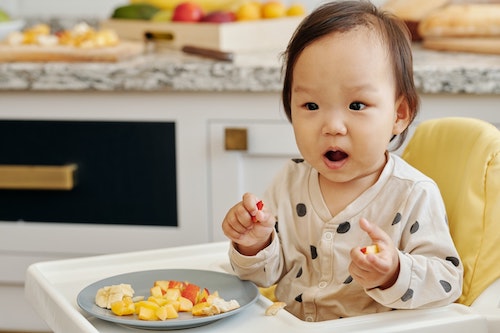
They also have probably developed a ‘pincer grasp’ which allows them the fine motor control to pick up small pieces of food.
- Smashed or halved blueberries or raspberries (do not give full, round pieces! they pose a high choking risk)
- Grated cheese
- Whole-wheat pasta and couscous
- Whole grain bread, cut into strips
- Peas and cooked beans (smashing them makes it easier for baby to grab)
- Pieces of homemade muffins or “baby cookies” made without sugar
- Slices of soft pears or soft apples
- Cheeses: give easy-to-chew cheeses in long slices that a baby can grasp. Do not give processed cheese slices or cubes of cheese.
Baby-Led Weaning Foods At 10-12 Months
At 10-12 months, you can begin offering your baby food that looks more like structured meals and stronger flavors, like citrus fruits. Mix-up your meals and continue offering your baby a variety of foods, while still focusing on nutrition.
You should still be giving milk or nursing 4-5 times a day, along with three meals.
- Bite-sized pieces of cooked chicken, with sweet potato pieces and sliced strawberries
- Full breakfast: an omelet with vegetables, sliced whole grain bread with a thin layer of butter or nut butter
- A baby charcuterie board: baby ‘O’ cereal and baby crackers with melon slices, or roasted apple wedges, small pieces of pork and cheese strips
- Tacos: bits of tortilla or rice with smashed beans and sliced avocadoes
- Pasta with tomato sauce and ground beef or quartered meatballs
- Grilled salmon pieces (or another type of fish) with rice and steamed vegetables, such as carrots and green beans
Since your babies are likely eating most of the food in front of them by now, it’s good to focus on nutrients in each meal.
Salmon may seem like a fancy choice for a baby (who might throw half of it on the floor), but salmon is one of the best first foods for babies because it has an impressive nutrition profile.
A baby’s portion (1 ounce) of cooked, wild salmon has approximately: 60 nutrition calories, 5 grams of protein, is packed with important vitamins and minerals and is a good source of both iron and omega fatty acids, which are important for baby’s brain health.
Citrus Fruits
Around 11 months, you can introduce citrus fruits such as orange, tangerine and clementine wedges. Remove the peel and seeds and allow your child to suck on the raw fruits for a new taste sensation.
Oranges and clementines (seedless or seeds removed) also make great snacks for when you are out of the house.
Baby-Led Weaning Foods For 1 Year Olds & Up
With baby-led weaning, the one-year mark is usually the goal for baby to eat family meals. If you’ve gone with another weaning method and spoon-fed your baby, they will likely be eating plenty of soft foods at this stage, too.
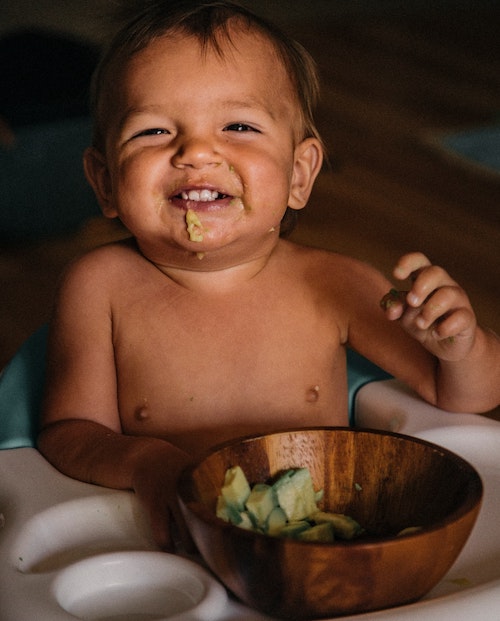
As young infants, babies obtain most of their nutrients from milk, but at one year of age, most babies are getting a good bulk of their overall nutrition from foods. By this age, your child is probably eating three meals a day, plus a small snack, as well as drinking milk 3 times a day. At this age, solids becomes important, not only in the amount a baby consumes, but also in nutritional content.
Ideally, at 1 years of age, your baby eats the same foods as you do, as long as they are bite-sized, soft solids that baby can easily handle to self-feed. Focus on offering balanced meals that are low in salt. Minimize saturated fat: don’t serve food which is deep fried or greasy.
The only new additions you might find are: cow’s milk and honey. This means you can serve more baked items (like homemade pancakes and muffins), but still minimize sugar as much as possible.
Foods To Avoid Before 12 Months?
The two biggest foods to avoid before 12 months of age are honey and cow’s milk.
Honey
Honey poses a serious health risk to infants called botulism. The age baby can safely eat honey is only after their first birthday.
Cow’s Milk
An infant’s stomach cannot properly digest this form of milk until they reach a year old. While babies can enjoy cheese and yogurts, these dairy products are more easily digested because they have fermented or been processed. Stick to breast milk or formula until one year.
Low-Fat Options
Babies should eat full-fat servings of things such as cheese and yogurt. They need that fat for their growing bodies and brains! Don’t give reduced or low-fat options of any dairy products until your child is much older.
Choking Hazards
Avoid dangerous foods that pose a high choking risk.
Wait to offer these foods until your child is older (usually around 3+ years old), and has mastered chewing, swallowing and has all their initial teeth.
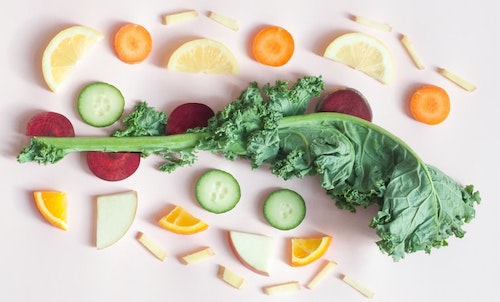
Some of the top choking hazards are:
- grapes
- cherry tomatoes
- raw vegetables which are hard
- whole nuts
- raw apple
- granola bars and crunchy biscuits/cookies
- sausages or hot dogs
- fish with bones
- cubes of cheese
- any meats cut in a thick slice
- all types of hard candy
- marshmallows
Introducing Allergens During Weaning
In regards to food allergies, the recommendations from the American Academy of Pediatrics have changed over the years.
Previously, experts thought it was better to delay introducing potential risks to your child until they were older, but now, data shows “no benefits to delaying” introducing allergens, as long as there is no predisposition for food allergies.
For example: if you have an older child with a severe food allergy.
Now, pediatricians recommend introducing common allergens as you start solids, but doing so in a slow, purposeful approach.
Timing
It’s advised to present new foods in the morning or afternoon meal times (not an evening meal). This way, you have more time to observe your baby and see any possible reactions or signs of a food allergy, which is harder to detect at night when they are sleeping.
Space Potential Allergens
When starting solids, cautiously introduce common allergens by introducing only one type per week. This way, if your child does present a reaction, you will know which food was the culprit.
Soy
Soy is present in many of the packaged food we consume, so it’s a good idea to determine an allergy early on. You can begin offering soy (in the form of tofu) from 6 months of age. I prefer to start it about a month into baby led weaning, when my child has started feeding themselves for a few weeks already.
Wheat
Doctors recommend waiting to introduce wheat until you have introduced other grains safely first, such as oatmeal and rice. As you introduce foods by age, I find starting wheat (usually as whole grain bread or whole wheat pasta) naturally falls around the 8-10 month mark for us.
Nuts
Tree nuts are a concern for some, and they should be served in a format babies can consume. Since you won’t be offering whole nuts until your child is much older, it makes sense to offer nut butter.
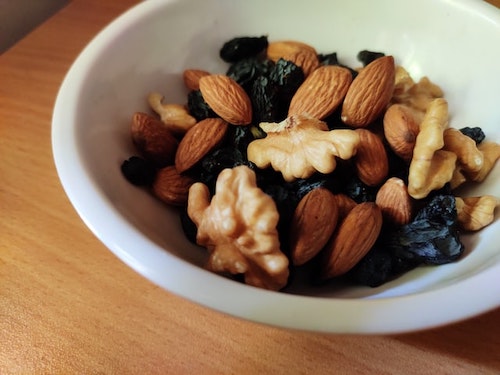
Ways to serve foods for baby-led weaning with nut butters could be atop strips of banana, or as a topping of pieces of bread or crackers.
Nuts offer plenty of nutrients to babies, so don’t be shy to use them, once you’ve determined your child has no reaction.
Dairy Products
Lactose (found in milk) is one type of common allergy, but children may not have a reaction to yogurt and cheeses, since they are more easily digested. Just to be safe, I introduce cheese and yogurt first, and present a child’s first cow’s milk at around 12 months of age.
When To Introduce Peanut Butter & Eggs?
Many parents are understandable nervous about giving their baby peanut butter and eggs, but new studies show that early introduction of common allergenic foods poses no additional health risks, and might even reduce the risks of food intolerance if introduced at an early age. There is a safe way to introduce these before 1 year of age.
Eggs
Eggs are a healthy form of protein and one of the best first foods. If you’re concerned about what age baby-led weaning followers should introduce eggs, know that you can do it as early as 6 months.
I prefer to wait until after baby has started on soy (tofu) and try eggs a week or so after. If you’re counting baby led weaning foods by age, my baby started eggs around 7.5 – 8 months.
Make sure to fully cook the egg – no runny centers. And if you’re offering hard boiled eggs, quarter the yolks.
Also, once you’ve started eggs with your baby, you can also offer homemade muffins or sugar-free baby banana bread made with eggs. These are great snacks that fit with my baby-led weaning style, and they don’t make a major mess.
Peanut Butter
Surprisingly, for children with a higher risk of peanut allergies, new data shows that early introduction is advised, as early at 4-6 months of age.
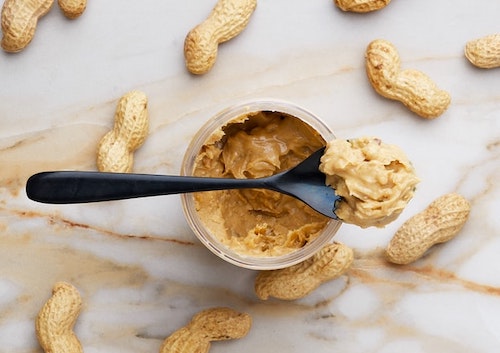
Numerous studies have concluded that sampling peanuts at an early age actually helped to reduce the risk of allergic reactions in high-risk children, compared to children who were only exposed to peanuts after the age of 1 or later.
Since 4-6 months may be before you begin baby-led weaning, you may consider offering it mixed in a puree. A peanut butter, yogurt and banana smoothie is pretty delicious, if I do say so myself.
How To Cut Foods For Baby Led Weaning?
6 months
As you’re just starting baby’s weaning journey, foods should be ‘finger-sized’: approximately the size of an adult index finger in length and width. Cut foods into a size and shape your baby can easily grasp, and keep peels on items such as bananas and avocados to make it easier for baby to suck or mash the food. As you follow guidelines for appropriate weaning foods by age, remember to offer soft foods that you can easily squash between your own fingers, as an estimate of how easy it is for your child to eat.
Here’s a few ideas:
- cut ripe bananas in halves or quarters, with peel still on
- thick slices of mango, avocado with peel still on
- long green beans, with ends removed
- sweet potato wedges
- soft carrot batons
8 months
The good news here is that your baby probably has their front teeth! This makes eating a little bit easier.
Your baby will likely eat solids confidently and have the improved motor skills to hold smaller bites of food, or thinner strips. You can offer meat served on the bone (like a chicken drumstick or a piece of beef or pork on the bone) for your child to gnaw at the soft pieces of meat.
10 months
By this age, babies usually have developed the pincer grasp and can select small pieces of food by picking up with their thumb and index finger. Therefore, foods can be cut into small, bite-size pieces, and shredded meat can be offered.
12 months
Your 1-year old can eat pretty much everything, as long as it is soft and an appropriate, small size. Remember, always supervise a child while they are eating.
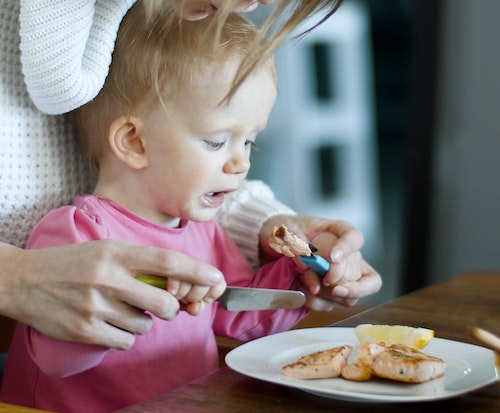
Can You Overfeed Baby When Doing BLW?
It is unlikely your baby will eat too much food with a baby-led weaning approach. If you offer plenty of healthy food options and follow baby’s lead, they will likely self-regulate and stop eating when they are full.
If you have concerns about how much food your baby eats, talk to your doctor.
Sources:
https://www.sdbfc.com/blog/2016/12/29/introducing-the-top-8-allergens-to-infants
https://www.ncbi.nlm.nih.gov/pmc/articles/PMC6157280/
https://www.contemporarypediatrics.com/view/early-introduction-big-eight-allergenic-foods
The purpose of this article is informative. It’s not a substitute for professional medical advice or medical care. Remember: safety first! Consult your doctor/pediatrician in case of any doubts. The author of this article does not accept any responsibility for any liability, loss or risk, personal or otherwise, incurred as a consequence, directly or indirectly, from any information or advice contained here.
| Your trust is really important to me: This article includes affiliate links to products that I think are useful for our readers. If you make a purchase through these links, I may earn a small commission at no extra cost to you. Your support helps me run this blog – thank you! |

